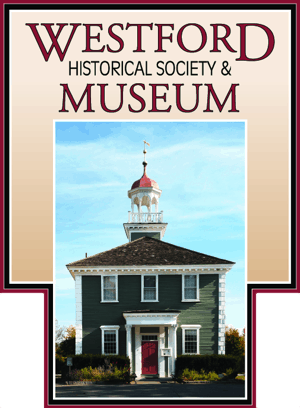Philanthropist, Industrialist, World Traveler
By James VanBever
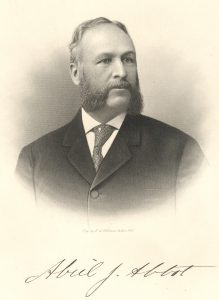 Abiel Jacob Abbot was born on January 8, 1850, in Westford, Massachusetts to John W.P. and Catherine Abbot. Abiel was one of six children. He was educated at Westford Academy, Highland Military Academy, Worcester, Phillips-Exeter Academy, and Massachusetts Institute of Technology.
Abiel Jacob Abbot was born on January 8, 1850, in Westford, Massachusetts to John W.P. and Catherine Abbot. Abiel was one of six children. He was educated at Westford Academy, Highland Military Academy, Worcester, Phillips-Exeter Academy, and Massachusetts Institute of Technology.
“At the age of 18, he entered the office of the Robey Mfg. Co. in Chelmsford and remained with them until 1873”. Abiel then returned to Westford and began his association with the Abbot Worsted Company. He would eventually become a partner and longtime treasurer.
The Abbot Worsted Company in Graniteville was founded in 1855 by John W. Abbot, John W.P. Abbot, and Charles G. Sargent. The Company manufactured fine worsted yarn braid and upholstery yarn. In 1855, the firm employed twenty people. Two years later, Mr. Sargent retired, and Allan Cameron became an active partner. In 1858, a fire destroyed the mill, but temporary operations were continued in Norwich, CT.
In 1859, a new granite mill was constructed in Graniteville. At first, the Company manufactured carded wool and later worsted wool, woolen carpet yarn, and camels’ hair yarn. Allan Cameron and Abiel Abbot, who became a partner in 1875, restructured the firm, expanded the business, and built large textile mills in Forge Village. They later bought Moore’s Mill at Brookside. The Company became known as Abbot and Company.
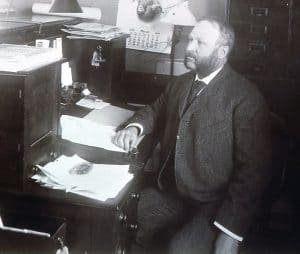 Aside from his long-term association with the Abbot Company, Mr. Abbot is also remembered as a world traveler and philanthropist, as well as for his dedication and interest in the town of Westford. He is also remembered as a long-time resident of the Abbot House on 32 Main Street.
Aside from his long-term association with the Abbot Company, Mr. Abbot is also remembered as a world traveler and philanthropist, as well as for his dedication and interest in the town of Westford. He is also remembered as a long-time resident of the Abbot House on 32 Main Street.
During his life Mr. Abbot was a world traveler and adventurer. Abiel and his family took many trips to such places as Hawaii, England, Australia, China, and Vancouver, Canada. Of course, all these journeys were before the advent of air travel. Mr. Abbot also spent several winters in California.
However, his most interesting trip may have been his expedition to the West Coast of South America in 1914. During the trip, Abiel visited Peru, Chili, Panama, and the Andes. On one occasion, Abiel’s ship, the Guatemala, had to anchor two miles off the shore of Panama to avoid yellow fever.
In Lima, Peru, Mr. Abbot visited the palaces of the viceroys, Senate chambers, and a church that had the coffin and remains of the great Spanish conquistador Francisco Pizarro. He was amazed that a church in Lima had a sign that advertised scotch whiskey. Also, in Peru, Abiel took note that the wild sheep had such fine wool. Finally, on the trip to Peru he was able to buy a $ 40.00 Panama hat for just $10.00. Abiel often gave talks about his travels upon his return to Westford.
At home, Abiel Abbot took an interest in the town of Westford and contributed to many town projects and causes. At the end of the 19th century, Catholics in Westford had to travel to St. Johns the Evangelist in Chelmsford to celebrate Mass. At this time, Catholic families decided to build their own mission church in Westford. Abiel Abbot and Alan Cameron both contributed to the building fund. In addition, Abiel signed a petition in which the Church was making to the town for permission to build a Catholic cemetery in Westford.
Mr. Abbot was also involved in the purchase of land in Graniteville, which became the Graniteville Ball Park. During World War I, he contributed $ 30,000 toward the purchase of liberty bonds. On another occasion, the Unitarian Society in Westford gave thanks to Abiel for his contribution toward the “painting and repairing the spike of the church.”
In other town affairs, Abbot served in Troop F, Spalding light cavalry. He was also the chairman of the Westford Public Library trustees, a member and chairman of the Westford school committee, and a member of the Westford Academy trustees.
In 1891, shortly after the death of Abiel’s mother, Abiel, his wife Mary Alice (Mosely), and their three children moved into “The Abiel and Alice Abbot House” at 32 Main Street. The house which was built in 1890, is one of the most notable Shingle style designs in Westford. Although Mr. Abbot was not a farmer, he kept horses and cows on the 32 Main Street property.
The “house is a sprawling two and one-half story, side-gable form with numerous bays, ells, dormers, and windows.” The Abbot’s living quarters were on the second floor, while the third floor, which had smaller rooms, were for the servants., Abiel Abbot lived in the home for the rest of his life.
Abiel Jacob Abbot died on May 1, 1921, at one of his homes in Brookline, Massachusetts. He was survived by his wife, Mary Alice, two sons, Edward and John, and a daughter, Alice. The funeral was held at the Unitarian church in Westford. The church was filled with family, friends, and business associates. All the Abbot Worsted mills closed for the afternoon and the flag on the Westford common was at half-mast.
Gordon B. Seavey, a Westford historian and lifelong resident of the town, recalled that he and town residents would ring the Church bell “lustily” on the common at midnight on the 4th of July. The only other times he can remember ringing the bell was upon the deaths of President Franklin D. Roosevelt and Abiel Jacob Abbot.
Sources:
Abbot Worsted Company Timeline
American Textile History Museum
Find a Grave Memorial, Abiel Jacob Abbot (1850-1921)
“Saturday Chat,” Lowell Courier Citizen, February 7, 1914, p. 6.
Ibid. May 2, 1921. p. 15.
Ibid. “Funeral Services for Ariel J. Abbot, May 5, 1921, p. 11.
“Westford,” Lowell Daily Courier, April 26, 1901, p. 8.
“A New Catholic Cemetery.” Lowell Sun, November 10, 1894, p. 1.
Ibid. “New Ball Park,” Lowell Sun, December 13, 1915, p. 4.
“Liberty Bonds,” Westford Wardsman, May 11, 1918, p. A9.
Patriotic Symbol as Clear as a Bell, Westford Eagle, 12 April 1990, p. 5
Ibid. “St. Catherine’s Celebrates its history,” October 16, 1997, p. 12.
The House That Abiel Built.
32 Main Street was constructed between May 1, 1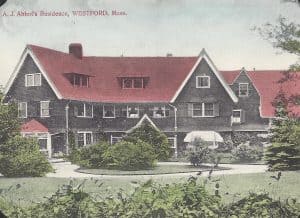 890, and June 1, 1891, by Abiel J. Abbot (1850-1921) and his wife, Alice (Mosely) Abbot. This house is recognized as one of Westford’s most impressive examples of Shingle style design. At the time of construction, Abiel and Alice were living with his mother at her home located at 44 Main Street. After his mother passed away in 1891, Abiel and Alice moved into 32 Main Street. Abiel was a fifth-generation member of the Abbot family who had arrived in Westford in the early 1730s.
890, and June 1, 1891, by Abiel J. Abbot (1850-1921) and his wife, Alice (Mosely) Abbot. This house is recognized as one of Westford’s most impressive examples of Shingle style design. At the time of construction, Abiel and Alice were living with his mother at her home located at 44 Main Street. After his mother passed away in 1891, Abiel and Alice moved into 32 Main Street. Abiel was a fifth-generation member of the Abbot family who had arrived in Westford in the early 1730s.
The couple’s son, Edward Moseley Abbot (1882-1958), moved into 32 Main Street after his mother died in 1931. He served as the president of the Abbot Worsted Company from 1934 until it closed its Forge Village operations in 1956. His widow, Natalie (1898-1983), continued to live in the house until her passing.
This house is a sprawling two-and-a-half-story structure with a side-gable form that features numerous bays, ell extensions, porches, dormers, and windows. Its large scale and well-maintained condition contribute to its prominence. The main section of the house has a steeply pitched roof with extensions projecting both east and west. Five dormers line the front slope of the gable roof, while four additional dormers are found at the rear. The dormers in the main block have hip roofs, while those on the east ell have gable roofs.
This two-and-a-half-story house features a side-gable design with multiple bays, ell extensions, porches, dormers, and windows. Its large size and well-maintained condition make it prominent. The main section has a steeply pitched roof with extensions on both sides. There are five dormers on the front slope and four at the rear, with hip roofs on the main block and gable roofs on the east ell.
The asymmetrically arranged windows vary in type and are grouped fluidly on the first and second floors. The wood-shingled exterior and asymmetrical design contribute significantly to the house’s character, along with its steeply pitched roof and two-and-a-half-story bay window on the west wall. (Source: House Tour Brochure 2017)
Abiel J. Abbot’s Obituary |
Posted in the Westford Wardman, May 7, 1921
“Death. Abiel J. Abbot, one of the best-known citizens of Westford, died at his winter home in Boston on last Sunday after a brief illness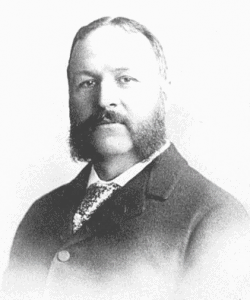 from bronchial pneumonia, aged seventy-one years. He was born in Westford on January 8, 1850, being one of six children of the late John W. P. and Catherine (Abbot) Abbot. He was educated at Westford Academy, Highland Military Academy,
from bronchial pneumonia, aged seventy-one years. He was born in Westford on January 8, 1850, being one of six children of the late John W. P. and Catherine (Abbot) Abbot. He was educated at Westford Academy, Highland Military Academy,
Worcester, Phillips-Exeter Academy, and Massachusetts Institute of Technology. He served as a member of Troop F, Spalding Light Cavalry, M.V.M. He was chairman of the trustees of Westford Public Library, member and chairman of the school committee for ten years, trustee of
Westford Academy, member of the Home Market Club, Boston, and member of the executive Committee of the National Association of Wool Manufacturers.
“Mr. Abbot, [the father,] with the late Allan Cameron [and Charles G. Sargent], organized the Abbot Worsted Co., and started business in a small way at Graniteville, and from this small beginning later developed the large mills at Forge Village and Brookside, and development has been steadily progressive….”
Abiel Jacob Abbot was a long-time treasurer, and son of the co-founder, of the Abbot Worsted Company. Courtesy Photo / “Souvenir of the Dedication of the J. V. Fletcher Library” (1896), p.36
